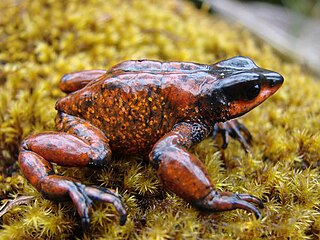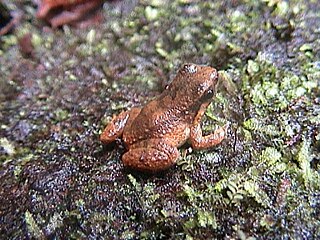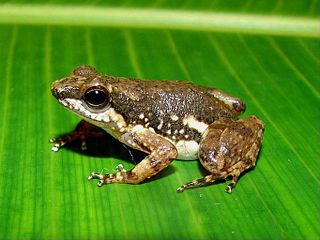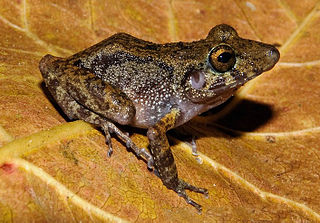
Colostethus is a genus of poison dart frogs native to Central and South America, from Panama south to Colombia, Ecuador, and northern Peru. Their common name is rocket frogs, but this name may refer to frogs in other genera and families, following the taxonomic revision of the genus in 2006.

The Panamanian golden frog is a species of toad endemic to Panama. Panamanian golden frogs inhabit the streams along the mountainous slopes of the Cordilleran cloud forests of west-central Panama. While the IUCN lists it as critically endangered, it may in fact have been extinct in the wild since 2007. Individuals have been collected for breeding in captivity in a bid to preserve the species. The alternative common name, Zetek's golden frog, and the epithet zeteki both commemorate the entomologist James Zetek.

The Guajira stubfoot toad or Carrikeri harlequin frog, Atelopus carrikeri, is a species of toad in the family Bufonidae. It is about 5 cm (2.0 in) long and typically black, though some populations have orange coloration. This species is endemic to the Sierra Nevada de Santa Marta mountain range of northern Colombia. It is critically endangered because of the chytrid fungus, Batrachochytrium dendrobatidis, and habitat destruction due to agriculture. The species had not been seen from 1994 until it was rediscovered in early 2008.
Hyloxalus cevallosi is a species of poison dart frogs in the family Dendrobatidae. It is named after Gabriel Cevallos García, a famous Ecuadorean writer. This species of frog exists on the east side of the Andes in Ecuador near the Pastaza Province as well as the Zamora-Chinchipe Province. Though it has been recorded in Peru, the records have yet to be confirmed. Its natural habitats are very humid premontane and pluvial premontane forests.

Anomaloglossus degranvillei is a species of frog in the Aromobatidae family. It is known from French Guiana but is likely to occur also in Suriname and Brazil, and possibly in Guyana. It is named in honour of Jean-Jacques de Granville, a botanist from French Guiana.
Hyloxalus edwardsi is a species of frogs in the family Dendrobatidae. It is endemic to the Cordillera Oriental in the Cundinamarca Department, Colombia. It is named after Stephen R. Edwards from the University of Kansas Natural History Museum, a colleague of John D. Lynch who described this species in 1982.

Colostethus fraterdanieli is a species of frog in the family Dendrobatidae. It is endemic to the Andes in Colombia. Colostethus yaguara might be its junior synonym. It lives on the ground close to streams in cloud forests and in dry tropical forests. It is threatened by habitat loss caused by agriculture and logging.

Colostethus inguinalis is a species of frog in the family Dendrobatidae. It is endemic to northwestern and northcentral Colombia. Its common name is common rocket frog, although this name can also refer to Colostethus panamansis that until 2004 was considered a junior synonym of Colostethus inguinalis. Much of the older literature on Colostethus inguinalis is actually about Colostethus panamansis.
Colostethus latinasus is a species of frog in the family Dendrobatidae. It is known from Cerro Pirre in Darién Province, Panama, from Chocó Department in adjacent Colombia, and from Tierralta, Córdoba Department, Colombia.

Allobates marchesianus is a species of frog in the Aromobatidae family. It is found in the Amazon Basin in Brazil, Colombia, Ecuador, Peru, and Venezuela. However, this species might represent a cryptic species complex, where at least the populations from Venezuela belong to an undescribed species. Its natural habitats are secondary and old-growth tropical rainforests, where it lives on the forest floor. It is threatened by habitat loss.

Rheobates palmatus is a species of frog in the family Aromobatidae; it is the type species of genus Rheobates erected in 2006. Its common name is palm rocket frog. It is endemic to Colombia. It is considered to be part of a species complex.

Colostethus pratti is a species of frog in the family Dendrobatidae. It is found in the northwestern Colombia and Panama, possibly also in southeastern Costa Rica. It is sometimes known as the Pratt's rocket frog. Colostethus pratti is named after Antwerp Edgar Pratt, an explorer who collected the type series.

Allobates talamancae is a species of frog in the Aromobatidae family. It is found in northwestern Ecuador, western Colombia, Panama, Costa Rica, and southern Nicaragua.
The Copan brook frog is a species of frog in the family Hylidae found in northeastern Guatemala and northwestern Honduras, specifically in the Sierra del Merendón, Sierra de Omoa, Sierra de Caral, and Sierra Espíritu Santo ranges. The colouring of this species is very distinctive and the specific name soralia comes from the resemblance of its markings to the vegetative structures on some crustose lichens.

Pristimantis gaigei is a species of frog in the family Craugastoridae. It is found in the Atlantic drainage lowlands from extreme southeastern Costa Rica to eastern Panama and to central Colombia; it is widely distributed in Colombia west of the Cordillera Oriental. Its natural habitat is primary humid lowland forest, but it also occurs in secondary forest. It is a nocturnal species found under surface debris and in leaf-litter.

Hemiphractus fasciatus, or the banded horned treefrog, is a species of frog in the Hemiphractidae family. It is found in central and eastern mountains of Panama, Pacific slopes of the Cordillera Occidental in Colombia, and northwestern Ecuador. It is a relatively large frog that may readily bite.

The Colombian four-eyed frog is a species of frog in the family Leptodactylidae. It is found in an area stretching from Guyana and northern Brazil through Venezuela and Colombia into Panama as well as the Netherlands Antilles.























